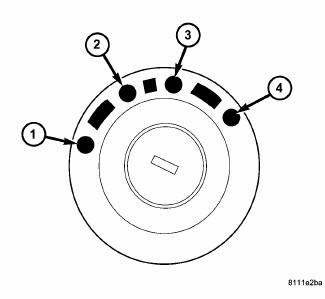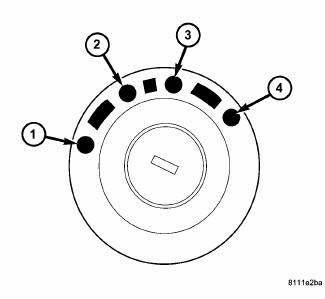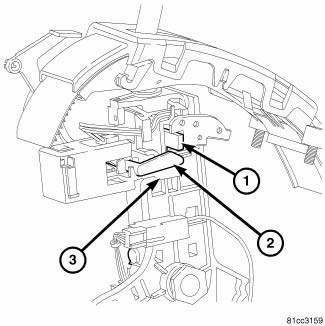Dodge Journey: Description, Operation
DESCRIPTION

Fig. 418: Identifying Ignition Key/Switch Positions
- - LOCK
- - ACC
- - ON
- - START
The Brake Transmission Shifter/Ignition Interlock (BTSI) is a solenoid operated system that prevents the transmission gear shifter from being moved out of PARK without a driver in place.
OPERATION

Fig. 419: Identifying Ignition Key/Switch Positions
- - LOCK
- - ACC
- - ON
- - START
The Brake Transmission Shifter/Ignition Interlock (BTSI) is engaged whenever the ignition switch is in the LOCK or ACC position. An additional electrically activated feature will prevent shifting out of the PARK position unless the brake pedal is depressed at least one-half inch. When the key is in the ON position and the brake pedal is depressed, the shifter is unlocked and will move into any position.

Fig. 420: Identifying Rotating Arm, Blocking Arm, & Shifter Gate Pin
When service brake pedal is not depressed the solenoid rotating arm (2) is free to rotate. The shifter gate pin (1) hits the blocking arm (3) and is prevented from moving from park.
When service brake is applied the rotating arm (2) is prevented from rotating by magnetic force within the solenoid. The shifter gate pin (1) pushes the rotating arm (2) and blocker arm (3) allowing the shifter to move out of park.
 Diagnosis and testing
Diagnosis and testing
SHIFT INTERLOCK SYSTEM
Fig. 421: Identifying Ignition Key/Switch Positions
- LOCK
- ACC
- ON
- START
The Shifter Response Table describes the normal operation of the
Brak ...
See also:
ELECTRICAL POWER OUTLETS
There are two fused 12 Volt (13 Amp) power outlets
located in the center console below the radio. The power
outlet on the top has power available when the ignition
switch in the ON or ACC position. ...
Removal, Installation
REMOVAL
WARNING: Disable the airbag system before attempting any steering
wheel, steering
column or instrument panel component diagnosis or service. Disconnect
and isolate the negati ...
Connector, data link
DESCRIPTION
Fig. 1: Data Link Connector
The Data Link Connector (DLC) (2) is a 16-way molded plastic connector
insulator on a dedicated take out of
the instrument panel wire harness. This conne ...

